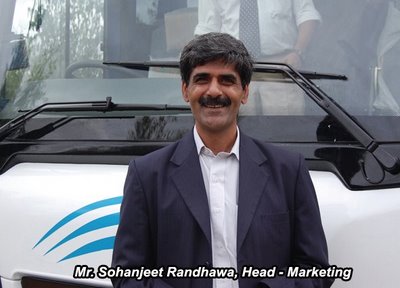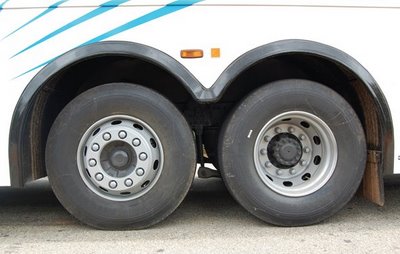 In keeping with its philosophy of setting standards and providing industry leading transport solutions, Volvo recently launched India’s first multi-axle coach, the Volvo 9400 B9R, at the Volvo Bus Technologies plant on the outskirts of Bangalore. The first six buses where delivered to the customers on the occasion.
In keeping with its philosophy of setting standards and providing industry leading transport solutions, Volvo recently launched India’s first multi-axle coach, the Volvo 9400 B9R, at the Volvo Bus Technologies plant on the outskirts of Bangalore. The first six buses where delivered to the customers on the occasion.
The launch of the multi-axle bus is a big step forward in the Indian bus segment, which is now on par with the global industry in terms of technology. As in the case of the passenger car segment, introduction of the Volvo 9400 in India was made just a few months after its launch worldwide. This confirms Volvo’s commitment to the Indian bus market, says Mr. Akash Passey, Managing Director of Volvo Bus Technologies.
“With the launch of this model, Volvo now has three standard offerings – 4×2 inter-city bus, city bus and 6×2 inter-city bus – for the Indian market. With this new model’s launch Volvo is broadening its product offering and choices for the customers and the passengers”, adds Mr. Passey.
The new Volvo multi-axle bus is 13.7 meters length, which is close to 1.7 meters longer than the existing Volvo B7R inter-city bus. The additional length means additional capacity, and this makes business sense for the operator. A normal B7R had the capacity to carry 45 passenger whereas the multi-axle coach can carry upto 53 passengers. For an operator, the additional 8 seats, if booked , can easily take care of the fuel cost of the trip, says Mr. Passey. This is just one of many advantages of the new bus. Ofcourse, it comes at a slightly higher price of Rs. 85 but Volvo believes that the new B9R is cheaper when it comes to per seat cost.
The new Volvo B9R comes powered by a 9-litre Euro III common rail engine. The 340 hp engine is the most powerful on Indian buses and features the Volvo Engine management system (EMS2) which provide for precise and efficient engine control. The engine control module takes in data from several sensors on the engine and the vehicle, compares current readings with stored parameters and adjusts fuel quantity and injection timing accordingly. It is integrated with the bus electronic system and permits communication with the driver via information display on the dashboard. This helps in efficient engine management and scope for diagnosis and fault tracing.
The B9R is fitted with 6 speed ZF gearbox with inbuilt Voith hydrodynamic retarders. It has a turning radius of 10.5 meters compared to the B7R which is 10.25 meters, which is very good considering the fact that the new bus is nearly 1.7 meters longer than the B7R.
Since it is a multi-axle bus, there are two axles in the rear. One is a powered axle and the other is dummy or a pusher axle, similar to the one on the 6X2 trucks. But the advantage for the traveller is that the B9R comes with 8 air bellows, which is 2 in the front and 6 in the rear compared to a normal bus which has only 2 air bellows in the rear. This makes for excellent driving experience, particularly on the rear end of the buses. The B9R also comes with double acting hydraulic telescopic shock absorbers, 2 front and 4 rear air & brake systems disc brakes combined with electronic braking system which controls the ABS and ASR functions.
In the seven-year history of Volvo buses in India, the company has helped bring in complete shift in the way this business is being conducted. Customers are becoming more corporate and Volvo has helped add to their status. Even within the segment of operators who own Volvo buses, many of the small operators who owned 2 to 3 Volvo buses have moved out by selling it to bigger operators. This has resulted in the emergence of a handful of key operators who run fleets ranging from 50 to 300 Volvo buses. This also makes the operations more viable in the long term.
Today Volvo has over 2,000 buses, both coaches and intercity buses, plying on Indian roads. Volvo has practically covered all major routes across India in the coach segment and in some of the routes, its has close to 100 per cent share. A typical example would be the Mumbai-Pune expressway route wherein over 200 Volvo buses are running and there is a Volvo bus leaving every 30 minutes.
The Volvo B9R is clearly generations ahead compared to the other buses manufactured in India. Volvo set standards in luxury bus segment by launching the B7R in 2001. The name Volvo has become synonymous to luxury bus travel in India. Tata Motors and Ashok Leyland have been working on products which can compete with Volvo in the top end but haven’t gained significant volumes yet. Mercedes has recently launched its luxury bus but it will take a longtime to establish itself in the market.
Given this scenario, Volvo has already moved to the next level of launching its multi-axles buses. It clearly shows its commitment to the Indian market and its clear vision to set high standards in the segment in which operates.
Volvo has already bagged orders for 20 multi-axle buses, of which 6 were delivered. The first few buses were delivered to some of its key customers including Kesineni Travels, Sharma Travels and Neeta travels. Volvo has priced this bus at Rs. 85 lakh (ex-factory). The bus features Electronic Brake System, a technology that ensures the highest safety for passengers and driver along with various safety features like frontal impact safety, roll-over protection among others.